Hopf Bifurcation of a Predator-Prey System with Delays and Stage Structure for the Prey
Abstract
This paper is concerned with a Holling type III predator-prey system with stage structure for the prey population and two time delays. The main result is given in terms of local stability and bifurcation. By choosing the time delay as a bifurcation parameter, sufficient conditions for the local stability of the positive equilibrium and the existence of periodic solutions via Hopf bifurcation with respect to both delays are obtained. In particular, explicit formulas that can determine the direction of the Hopf bifurcation and the stability of the bifurcating periodic solutions are established by using the normal form method and center manifold theorem. Finally, numerical simulations supporting the theoretical analysis are also included.
1. Introduction
The organization of this paper is as follows. In Section 2, by analyzing the corresponding characteristic equations, the local stability of the positive equilibrium of system (1.4) is discussed, and the existence of Hopf bifurcation at the positive equilibrium is established. In Section 3, we determine the direction of Hopf bifurcation and the stability of bifurcating periodic solutions by using the normal form theory and center manifold theorem in [20]. And numerical simulations are carried out in Section 4 to illustrate the main theoretical results. Finally, main conclusions are included.
2. Local Stability and Hopf Bifurcation
Next, we consider the local stability of the positive equilibrium and the Hopf bifurcation of system (1.4) for the different combination of τ1 and τ2.
Case 1. (τ1 = τ2 = 0). The characteristic equation (2.5) becomes
It is not difficult to verify that m12 > 0 and m10 > 0. Thus, all the roots of (2.6) must have negative real parts, if the following condition holds: H11 : m12m11 > m10. Namely, the positive equilibrium is locally stable in the absence of time delay, if H11 holds.
Case 2. (τ1 > 0, τ2 = 0). On substituting τ2 = 0, (2.5) becomes
Let λ = iω1(ω1 > 0) be a root of (2.7). Then, we have
Let , then (2.9) becomes
H21: equation (2.10) has at least one positive root.
Let , k ∈ {1,2, 3}, .
Therefore, if holds. Notice that and have the same sign. Then we have if H22 holds. In conclusion, we have the following results.
Theorem 2.1. Suppose that the conditions H21 and H22 hold. The positive equilibrium E0 of system (1.4) is asymptotically stable for τ1 ∈ [0, τ10) and unstable when τ1 > τ10. Further, system (1.4) undergoes a Hopf bifurcation when τ1 = τ10.
Case 3. (τ2 > 0, τ1 = 0). On substituting τ2 = 0, (2.5) becomes
Let λ = iω2(ω2 > 0) be a root of (2.18). Then, we get
Let , then (2.20) becomes
H31: equation (2.21) has at least one positive root.
Without loss of generality, we assume that it has three positive roots denoted by v21, v22, and v23. Thus, (2.20) has three positive roots .
Let , k ∈ {1,2, 3}, .
Similar as in case (1), next, we suppose that the condition holds, where . Then we have . By the above analysis, we have the following results.
Theorem 2.2. Suppose that the conditions H31 and H32 hold. The positive equilibrium E0 of system (1.4) is asymptotically stable for τ2 ∈ [0, τ20) and unstable when τ2 > τ20. Further, system (1.4) undergoes a Hopf bifurcation when τ2 = τ20.
Case 4. (τ1 = τ2 = τ > 0).
For τ1 = τ2 = τ > 0, (2.5) can be rewritten in the following form:
Multiplying eλτ on both sides of (2.24), it is obvious to get
It follows that
From (2.27), we can get
Let ω2 = v3, then (2.28) becomes
The corresponding critical value of time delay is
Next, we verify the transversality condition. Differentiating (2.25) regarding τ and substituting τ = τ0, we get
Theorem 2.3. Suppose that the conditions H41 and H42 hold. The positive equilibrium E0 of system (1.4) is asymptotically stable for τ ∈ [0, τ0) and unstable when τ > τ0. Further, system (1.4) undergoes a Hopf bifurcation when τ = τ0.
Case 5. (τ1 > 0 and τ2 ∈ [0, τ20)).
We consider (2.5) with τ2 in its stable interval, and τ1 is considered as a parameter.
Let λ = iω1*(ω1* > 0) be the root of (2.5). Then, we have
In order to give the main results, we suppose that (2.35) has finite positive root. We denote the positive roots of (2.35) as ω51, ω52 ⋯ ω5k. For every ω5i(i = 1,2, …, k), the corresponding critical value of time delay is
In the following, we differentiate the two sides of (2.5) with respect to τ1 to verify the transversality condition.
Taking the derivative of λ with respect to τ1 in (2.5) and substituting , we get
Theorem 2.4. Suppose that the conditions H51 and H52 hold and τ2 ∈ [0, τ20). The positive equilibrium E0 of system (1.4) is asymptotically stable for and unstable when . Further, system (1.4) undergoes a Hopf bifurcation when .
Case 6. (τ2 > 0 and τ1 ∈ [0, τ10)).
We consider (2.5) with τ1 in its stable interval, and τ2 is considered as a parameter.
Substitute λ = iω2*(ω2* > 0) into (2.5). Then, we get
Similar as in case (5), we give the following assumption. H61: (2.39) has finite positive root.
The positive roots of (2.39) are denoted as ω61, ω62,…,ω6k. For every ω6i (i = 1,2, …, k), the corresponding critical value of time delay is
Let , and is the corresponding root of (2.39) with .
Then, we suppose that holds. By the general Hopf bifurcation theorem for FDEs in Hale [26], we have the following results.
3. Direction and Stability of Bifurcated Periodic Solutions
In Section 2, we have obtained the conditions under which a family of periodic solutions bifurcate from the positive equilibrium of system (1.4) when the delay crosses through the critical value. In this section, we will determine the direction of Hopf bifurcation and stability of bifurcating periodic solutions of system (1.4) with respect to τ1 for τ2 ∈ (0, τ20) by using the normal form method and center manifold theorem introduced by Hassard et al. [20]. It is considered that system (1.4) undergoes Hopf bifurcation at . Without loss of generality, we assume that , where .
By the discussion in Section 2, we know that are eigenvalues of A(0). Thus, they are also eigenvalues of A*.
Based on the above discussion, we can obtain the following results.
Theorem 3.1. From (3.20) one has
- (i)
the direction of the Hopf bifurcation is determined by the sign of δ: if δ > 0(δ < 0), then the Hopf bifurcation is supercritical (subcritical);
- (ii)
the stability of bifurcating periodic solutions is determined by the sign of σ: if σ < 0(σ > 0), the bifurcating periodic solutions are stable (unstable);
- (iii)
the period of the bifurcating periodic solution is determined by the sign of T: if T > 0(T < 0), the bifurcating periodic solution increases (decreases).
4. Numerical Example
For τ1 > 0, τ2 = 0, we can get ω10 = 1.3881, τ10 = 0.9032. From Theorem 2.2, we know that the positive equilibrium is asymptotically stable when τ1 ∈ [0, τ10). The corresponding waveform and the phase plot are illustrated by Figure 1. When the time delay τ1 passes through the critical value τ10, the positive equilibrium will lose its stability and a Hopf bifurcation occurs, and a family of periodic solutions bifurcate from the positive equilibrium . This property is illustrated by the numerical simulation in Figure 2. Similarly, we have ω20 = 0.8497, τ20 = 0.5124, when τ2 > 0, τ1 = 0. The corresponding waveform and the phase plots are shown in Figures 3 and 4.
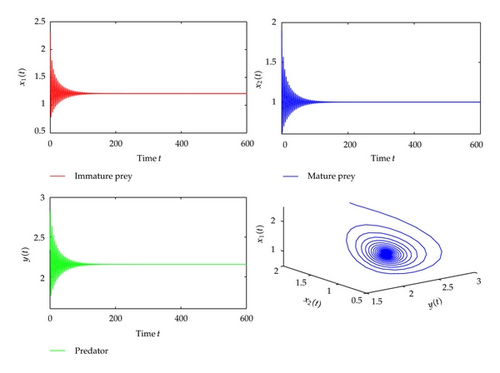
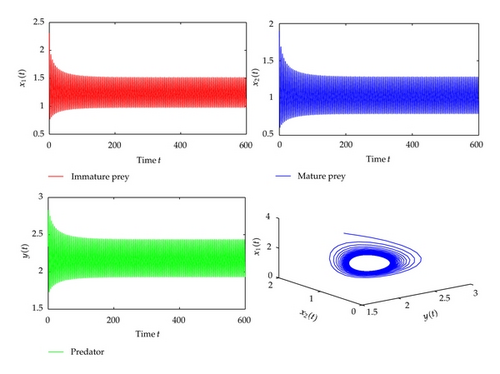
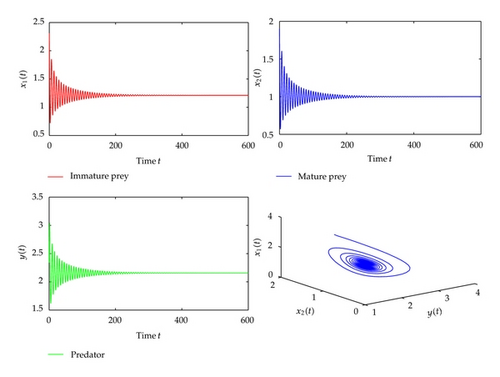
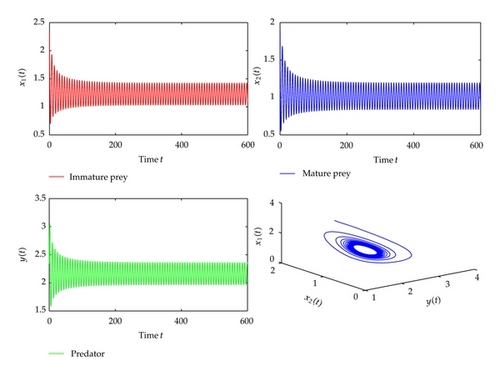
For τ1 = τ2 = τ > 0, we can obtain ω0 = 1.0000, τ0 = 0.4178. From Theorem 2.2, we know that, when the time delay τ increases from zero to τ0, the positive equilibrium is asymptotically stable. Once the time delay τ passes through the critical value τ0, the positive equilibrium will lose its stability and a Hopf bifurcation occurs. This property is illustrated by the numerical simulation in Figures 5 and 6.
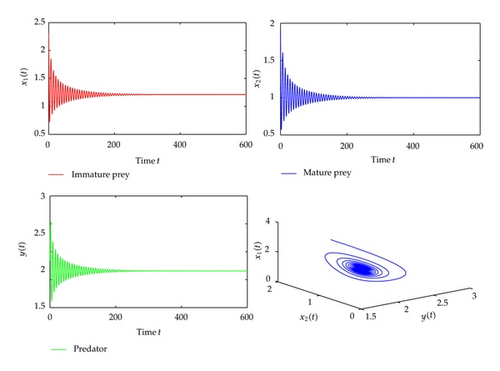
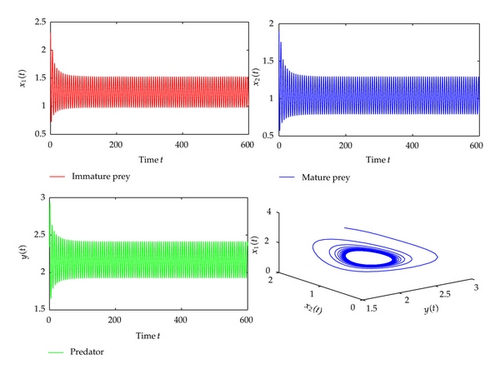
For τ1 > 0 and , we have , . According to Theorem 2.2, the positive equilibrium is asymptotically stable when and unstable when , which can be depicted by the numerical simulation in Figures 7 and 8. In addition, from (3.20), we can obtain C1(0) = −1.1949 + 3.2464i, δ = −23.4294, σ = −2.3898, T = 2.4949. Thus, from Theorem 2.3, we know that the Hopf bifurcation with respect to τ1 with is subcritical, the bifurcating periodic solutions are stable and increase. Similarly, we have , , for τ2 > 0 and . The corresponding waveform and the phase plots are shown in Figures 9 and 10.
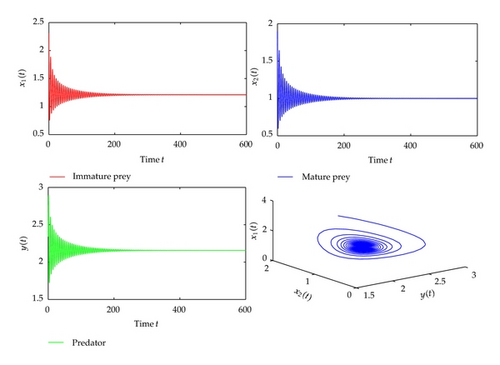
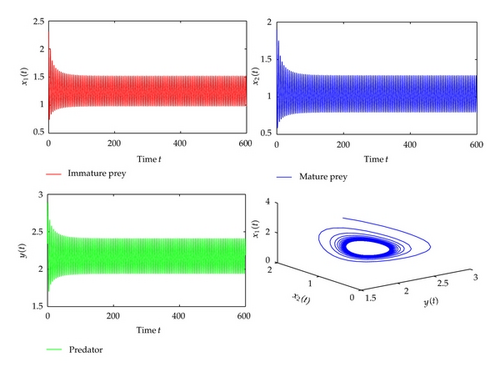

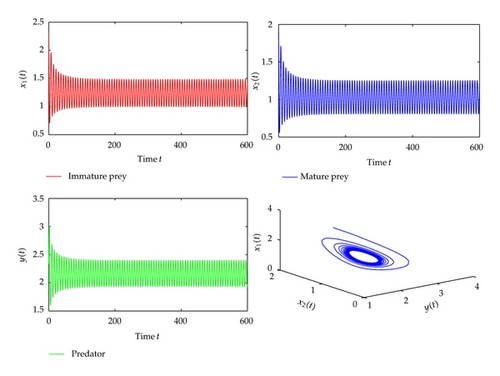
5. Conclusions
In this paper, a delayed predator-prey system with Holling type III functional response and stage structure for the prey population is investigated. Compared with literature [14], we consider not only the time delay due to the gestation of the predator but also the negative feedback of the mature prey density and the intraspecific competition of the immature prey population. F. Li and H. W. Li [14] has obtained that the species in system (4.1) with only the time delay due to the gestation of the predator could coexist. However, we get that the species could also coexist with some available time delays of the mature prey and the predator. This is valuable from the view of ecology.
The sufficient conditions for the local stability of the positive equilibrium and the existence of local Hopf bifurcation for the possible combinations of two delays are obtained. The main results are given in Theorems 2.1–2.5. By computation, we find that the time delay due to the gestation of the predator is marked because the critical value of τ2 is smaller than that of τ1 when we only consider them, respectively. Furthermore, the explicit formulae which determines the direction of the bifurcation and the stability of the bifurcating periodic solutions is established when τ > 0 and τ2 ∈ [0, τ20) by using the normal form theory and center manifold theorem. The main results are given in Theorem 2.3. Finally, numerical simulations are carried out to support the obtained theoretical results.
Acknowledgments
The authors are grateful to the anonymous reviewers for their helpful comments and valuable suggestions on improving the paper. This work was supported by the National Natural Science Foundation of China (61273070), Doctor Candidate Foundation of Jiangnan University (JUDCF12030) and Anhui Provincial Natural Science Foundation under Grant no. 1208085QA11.




